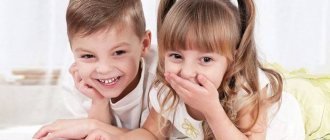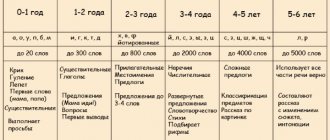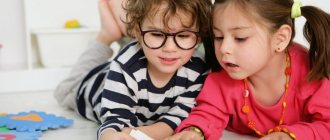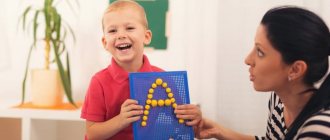Children 3–4 years old are called why. They are interested in everything that surrounds them and what happens around them. Therefore, the main distinguishing feature of speech development at this age is the interrogative construction: why? How? For what? what happens if? At the same time, it is important for parents to remember that each question requires an answer, but one that is as clear and concise as possible, since children are not yet able to listen carefully to long explanations.
Features of speech at 3-4 years
Speaking globally, the speech development of children now has the following characteristics.
- Intensive speech acquisition: growth of vocabulary, complication of speech structures, improvement of articulation.
- K.I. Chukovsky characterized this period as “brilliant linguistic talent”: now kids are actively engaged in word creation, creating the most unimaginable words and syntactic structures, trying to rhyme, composing poems, often understandable only to themselves.
- Children's speech is situational, that is, it is not prepared and is determined by a specific situation.
With a more detailed division, one can highlight the distinctive features in the improvement of various areas.
- Active vocabulary.
A child's vocabulary may consist of 1500–2000 words. At the same time, long or incomprehensible words are often distorted (“litekrichestvo” - electricity, “salamot” - airplane). The child can rearrange sounds or syllables in them (“paravachivay” - turn, “zvyat” - take, “gamazin” - shop). Now it is still difficult for the baby to pronounce sound combinations of two or more consonants. He can insert a vowel sound between them or skip half of the consonants (“drastuy” - hello, “zinayu” - I know).
- The grammatical structure of speech.
At 3 years old, a child’s phrases consist of 3-4 words; by 4 years old, he uses common sentences. Many kids can use complex and even complex constructions (Misha wants to eat, I’ll cook porridge. When summer comes, flowers bloom). Children begin to use simple homogeneous members in both singular and plural in their speech (I draw the sun and clouds. Geese swim and cackle). However, it may be difficult to form the plural of some words (mouths, trees). Children learn to use more parts of speech in conversation - adjectives, pronouns, adverbs, and numerals appear. But speech errors are still possible when coordinating the endings of adjectives and nouns, when changing verbs by persons and numbers.
- Phonetics.
The baby’s articulatory apparatus is gradually strengthening, he lisps less - he pronounces vowels without softening (“myasya” - meat, “syadik” - kindergarten). But phonetic errors are still possible that do not require special correction. For example, not being able to pronounce hissing words, a child replaces them with whistling ones (“sapka” - hat, “yezik” - hedgehog). The sounds [ts] and [h] are still “broken down into components” (“tsyplenok” - chicken, “tai” or “tsai” - tea). There are frequent problems with the pronunciation of sonorant [l] and [r]. They are either skipped altogether or replaced with [j], [l'], [v] (“ozhka” - spoon, “gavava” - head, “kiowa” - cow, “let” - mouth).
- Coherent speech.
Children 3–4 years old independently, without additional questions, cannot yet coherently and logically present what happened or saw, retell what adults read to them, or compose a complete story from a picture. They can only describe the objects depicted and the actions they perform (“This is a duckling. He is eating grass. There is a duck. This is his mother. She is standing and looking at the duckling”). But the kids are now actively remembering and reproducing various rhymes and nursery rhymes that they understand in their meaning.
- Intonation, expressiveness.
Children can now not only copy the shades of intonation that adults showed them when reading a poem, but also introduce their own expressive notes, which they think correspond to what they read. However, in the fourth year of life, children are not always able to adjust the tempo and volume of speech. They may not realize that they speak too quietly, especially when communicating with people they don't know well. And being strongly impressed by something, they talk about it, “choking on emotions,” confusedly and hastily.
Norms for child speech development at 3 years old
There are certain standards for a child’s speech at 3 years old. Typically, children at this age can already:
- Tell them what their name is, what gender they are and how old they are (when telling their age, they often use their fingers for clarity);
- Summarize objects that have the same purpose or are similar in some way (dishes, clothes, tools, toys, flowers);
- Speak in sentences that consist of 3-5 words;
- Construct sentences that contain significantly fewer grammatical errors than before (the presence of these errors is still normal);
- Use diminutive suffixes and “try on” words of new parts of speech: pronouns, numerals, possessive adjectives, adverbs;
- Correctly put emphasis in words (but for now it is allowed to make mistakes);
- Correctly pronounce the vast majority of sounds (zh, sh, ch', shch', r, r', l may still not be produced);
- Vocabulary of about 1500 words.
In addition, the development of speech in 3-year-old children is unthinkable without so-called word creation, when children begin to “invent” new words. It is this process that causes the greatest tenderness in adults, and yet this suggests that the child is trying to intuitively apply the laws of word construction, albeit in his own way.
"Speech Standards"
Many experts jokingly say that children at this age are silent only when they sleep. That is, in terms of speech, they are incredibly active. But parents cannot always determine whether their baby’s speech is developing normally. What if he doesn't talk much? What if it’s wrong for him to jabber endlessly? What if he pronounces sounds too vaguely?
As a guide, in addition to the above skills, you can refer to the approximate age speech norms.
- By the age of 3–4 years, children have already accumulated some life experience and knowledge about objects and phenomena, so they can reason and draw simple conclusions.
- The child already knows and names his last name, first name and patronymic, the names of his parents, close relatives, and friends.
- Can name and generalize into groups all objects known to him (food, clothing, furniture, dishes, toys).
- Can identify and name the signs of objects (the sun is hot, the apple is tasty, the hat is warm, the table is wooden).
- Understands and names the actions of objects (dad is sleeping, a sparrow is jumping, a cat is washing itself).
- Enjoys repeating words and sentences after adults.
- Can represent simple images.
If the baby cannot yet do all of the above, perhaps he simply lacks parental attention, which should be directed to correcting specific speech indicators.
Only obvious symptoms of a child’s lagging behind in speech development should be alarming:
- slurred monotonous speech;
- fast, choppy or drawn out speech;
- incomprehensible “gibberish”;
- speech is not formed into sentences with subjects, predicates, prepositions, and objects;
- the baby pronounces only phrases from cartoons or books, without constructing his own;
- cannot complete simple 2-step instructions (get a book from the shelf and take it to dad);
- “eats” the endings of words;
- constantly confuses the order of syllables or sounds in most words, distorts or replaces many sounds with others;
- does not use prepositions, conjunctions, or adverbs in speech;
- does not speak full words at all;
- the child’s mouth is constantly open and saliva flows;
- he has poor balance, is awkward, has poor coordination (can’t cross obstacles, catch a ball, climb stairs, stand on one leg);
- cannot perform small movements (fasten buttons, accurately insert mosaic pieces into holes, assemble Legos, presses hard on a pencil when drawing);
- inattentive, unable to concentrate;
- hyperactive or, conversely, too inhibited.
Such signs require mandatory consultation with specialists (pediatrician, neurologist, psychiatrist, psychologist, speech therapist, defectologist, otolaryngologist, audiologist). Not only speech correction may be needed, but also complex treatment if disturbances in the functioning of the central nervous system, hearing organs or articulation are detected.
How to determine speech delay?
Some children experience delayed speech development. It is important for parents to suspect the presence of a deviation in time. To do this, you need to know the features of speech development in young children. They are shown in the table below.
The formation of speech begins with humming
| Age | Features of speech |
| 1.5-2 months | revelry |
| 4 months | babble |
| 7-8.5 months | babble, repetition of well-produced syllable chains |
| 9-11 months | first words |
| year | knowledge of 10 words |
| 1-2 years | formation of phrasal speech |
| 2-3 years | constructing simple sentences from several words |
| 3-4 years | formation of coherent language |
Common signs of speech delay:
- the baby gurgles a little, babbles, is silent;
- at one year old the baby does not respond to sound;
- At 2 years old, the child does not perform actions at the request of his parents. Cannot string words together into simple phrases;
- at 3 years of age there is no own speech;
- Gestures and facial expressions are used primarily for communication;
- There is profuse salivation, which is not associated with teething.
To eliminate delayed speech development, it is necessary to identify and eliminate the influence of the factor that provoked the appearance of such a problem.
Experts identify the following main reasons:
- intrauterine problems, birth injuries;
- delayed neuropsychic development;
- receiving a traumatic brain injury at an early age;
- hearing problems (deafness, hearing loss);
- psychological disorders;
- lack of communication.
How can parents help?
If everything is fine with the baby, you should not think that his speech will form on its own. It has already been said here what problems are typical for children 3–4 years old. These are what you need to work on, constantly playing exciting games with children that develop speech.
So, what exactly needs the attention of adults now?
- Logical thinking, attention, memory. This will allow the child to remember more of what he read or saw, reason about it, draw conclusions, and express his thoughts consistently.
- The ability to use words in speech syntactically correctly (use gender, number, case, person to use the correct endings).
- Expanding vocabulary. This is one of the most important aspects of speech development, allowing the baby to speak fully, clearly and widely.
- Mastering different forms of speech (dialogue, monologue, description).
- Working on improving articulation. This is important so that the baby can quickly master sounds that are difficult for him (you can read more about articulatory gymnastics here).
- Expressiveness, tempo, intonation. The child needs to be taught to speak with the right strength of voice, according to the situation, to color speech emotionally, not to jabber or drag out words.
- Phonemic hearing. It is important for a child to learn to correctly perceive each sound in a word, to hear the number of syllables and their order.
- Fine motor skills. It will help the child improve pronunciation and activate the brain centers responsible for speech development (examples of games for the development of motor skills can be found here - “Hand motor skills for speech development”).
Pay special attention to those problems that your child has specifically (perhaps he cannot group objects according to common characteristics, or does not pronounce specific sounds, or has difficulty remembering text).
Features of speech development of preschool children 3–4 years old
Yulia Zakharova
Features of speech development of preschool children 3–4 years old
Features of speech development of preschoolers 3-4 years old.
The problem speech development preschool age acquires its relevance in connection with the psychophysiological characteristics of child development in the period of 3-4 years, in view of the sensitivity of speech development . It is at this age that the child is most sensitive to the perception of the speech of others, as well as to the influence of various factors from the external and internal environment, therefore, this age is especially productive for the child’s speech development .
Currently, the educational program of a preschool institution is built in accordance with the Federal State Educational Standard. One of the areas of the Federal State Educational Standard for Preschool Education in a preschool institution is speech development , which includes a focus on children’s mastery of speech as a means of communication and culture, the development of the grammatical side, the enrichment of vocabulary, the development of monologue and dialogic speech, its coherence.
In preschool age, speech plays a dominant role in the development of the child’s higher mental functions; it is directly related to the development and formation of processes such as thinking, memory, perception, attention, and imagination. Speech is closely related to the development of thought processes: analysis, synthesis, abstraction, generalization, inference, i.e. the higher the level of speech development , the qualitatively higher the child’s intelligence will be. Language acquisition also significantly influences the formation of productive, conscious, non-mechanical memory. At the age of 3-4 years, preschoolers experience a transition from sensory experience to generalized cognition; this occurs as a result of a restructuring of perception, which qualitatively changes under the influence of speech development . Attention becomes voluntary, ceasing to obey the laws of the orienting reflex. The mother's word is a stimulus that reorganizes attention, highlighting verbal instructions from a number of other stimuli. This is how the formation of conscious and organized attention, which has a social basis, occurs. By the end of early childhood, the child experiences a transition from reproductive imagination, characterized by reproducing experiences, to creative thinking. Thus, speech and its development are in close relationship with all the mental processes of the child, and therefore it is very important to promote its development precisely in the period of 3-4 years, the most favorable and plastic for the child.
What are the norms of speech development at 3-4 years old ? Many parents are concerned about this issue. Below are the norms for speech development of preschoolers aged 3-4 years .
• The active vocabulary is 1500-2000 words.
• Problems with the pronunciation of whistling and hissing sounds ([s], [z], [zh], [sh], [ts], [h], [sch] and their soft analogues, sounds [r] and [l] and their soft counterparts.
• Perseverations in syllables of words (bride - venesta, tulips-coats, mathematics - themes, etc., also confusion in sounds (airplane - famaet)
• Confusion with pronouns, word endings (my mom, my dad, Elya brought a toy, I want to drink water, etc.)
• Inability to create complete, logically complete stories.
• Active interest in memorizing words, poems, and rhyming words.
Thus, at 3-4 years old with normal speech development should be able to :
• State your first name, last name, patronymic.
• Name the names of relatives, friends and acquaintances.
• Describe the situation you saw.
• Retell the plots of fairy tales and cartoons.
• Name the signs and properties of objects (soft, glass, transparent)
.
• Name actions (sit, play, run, clean)
.
• Summarize objects (dishes, toys, vehicles, animals)
.
• Change the volume of your voice, speaking loudly and softly.
• Speak in simple sentences, gradually moving to complex ones.
The development of speech in a preschool child requires active adult intervention. In order for a child to more accurately assimilate all speech norms, it is necessary to use certain methods.
1. First of all, you need to talk to the child as much as possible, starting with the verbalization of various types of actions, it is necessary to describe to the child what he saw, ask him to do the same. It is necessary to introduce the preschooler to new words , explain and show their meaning, consolidate them in the child’s speech, thereby enriching the active and passive vocabulary. You need to ask your child more often what he did in kindergarten, on a walk, what he saw, what he learned new.
2. If you are concerned about the child’s pronunciation, distortion or absence of certain sounds, you must resort to performing articulatory gymnastics, the so-called “Tongue Games”
, such as: a house, a swing, pancakes, football, a needle, a straw, etc. Articulation exercises will activate the muscles of the tongue, cheeks, lips, thereby creating a favorable basis for correct pronunciation.
3. The development of fine motor skills plays a significant role in the child’s speech development , this is due to the fact that the nerve centers responsible for speech and fine motor skills in the cerebral cortex are in close relationship. Therefore, the better are developed , the clearer and clearer his speech will be. develop fine motor skills through modeling, drawing and appliqué, using special finger games ( “Flower”
,
“Pancakes”
,
“Boat”
,
“Lanterns”
,
“Hedgehog”
, etc., games with lacing, games with sand, natural materials, sensory boxes.
4. Involving theatricality in speech development can contribute to the development of emotionality and expressiveness of speech, improve sound pronunciation and intonation, and activate the child’s vocabulary. You can use shadow and finger theaters, use costumes and masks to create interest in the child in the process of dramatization. It is best to use the most suitable fairy tales for the age of 3-4 years: “Kolobok”
,
“Three Bears”
,
“Ryaba Hen”
,
“Turnip”
.
5. Of course, speech development is not complete without special speech games . Currently, there are many varieties of such games aimed at developing all aspects of speech : semantic, lexical-grammatical, emotional-intonation and sound pronunciation.
Thus, by encouraging the child to constantly make verbal statements, creating special conditions for organized development , it is possible to achieve high results in the speech development of a preschooler , which will significantly affect the development of all mental processes and facilitate the process of socialization of the child.
We practice while playing
What activities should you teach children to help them learn all these skills? Of course, gaming. This is the most accessible and interesting activity for a child. You can select your own games for each individual skill. At the same time, it is not necessary to specifically buy expensive manuals or toys.
- To develop logic, it is useful to assemble simple puzzles (3-4 pieces), find differences in pictures, combine objects into groups not only according to obvious signs (dishes, clothes), but also less understandable at first glance (for example, by the sign “red” you can combine ball, cube, mug, ladybug, car). You can also isolate an extra item from a group. Then, for example, a ladybug will be superfluous here, because it is alive. An exercise in which you need to determine which object corresponds to which contour on paper corresponds to which object will also make the child think (you cannot apply it). It is useful to arrange several items by size - from largest to smallest and vice versa. Option: arrange the pots and pans and put their lids separately - let the child choose his own “hat” for each.
- Memory and attention are trained , for example, by the following exercise: name everything that is on the table with your eyes closed, and then open your eyes and determine which object has disappeared. Or determine what has changed in the picture (the mother completed the drawing) while the baby was not looking. You can let your child memorize several objects, and then, when he closes his eyes, add another one - let him find a new one. You can offer your child pictures with errors (a green goose, a cow with wings, a hare eating a mouse, etc.) - let him indicate what the catch is.
- Exercises for developing the skill of correctly using word forms can be as follows. Moving an object (on the table, under, in front, behind, above), when the baby needs to say: the ball is on the table, the ball is under the table, etc. Exercises for comparing objects by quantity: one, few, many (you have a lot sweets, but I don’t have enough; there are a lot of apples on the table, but I have only one). A useful game will be when the child is asked to answer fully what object lying in front of him can do what (I draw with a pencil, I go for a walk in a hat). Another option: an adult describes one of the objects or toys in front of the child, and he must guess what it is about (she has a fluffy red tail, small paws, she loves nuts, her house is a hollow in a tree).
- Expressiveness of speech, strength of voice, intonation. These skills are perfectly developed by role-playing various folk tales (“Three Bears”, “Teremok”). An adult reads a fairy tale to a child expressively, changing the intonation and strength of his voice, then asks the child to voice one of the characters, then another (Mikhail Potapych, Nastasya Petrovna, Mishutka, Mashenka). Let the child guess by the tone of his voice which character’s phrase the adult read. Then you can switch roles with your child. The strength of the voice can be trained by explaining to the baby that the bell rings loudly, but the leaf from the tree falls very quietly. When he sees a bell, he must say something loudly; when he sees a leaf, he must say something quietly.
- Different forms of speech. Dialogue speech develops directly when an adult communicates with a child. By answering questions, the baby will gradually learn to construct both more detailed answer sentences and his own questions. A monologue is, first of all, a child’s story about something that happened to him or was especially interesting to him. The more often you ask him about this, the faster he will learn to build a coherent and complete story. Description is easiest to master by telling what is shown in a drawing, a painting, what is visible from the window, what is happening in the sandbox during a walk.
Speech development in a child up to 3 years old. How to develop a child's speech?
20.02.2020
From birth to 3 years, children have the most intensive stage of development; they acquire many new skills and improve them. If during this period you let the child’s development take its course, then in the future it will take much more effort to catch up.
Speech is the work of muscles and speech organs. And like any muscle, speech needs to be constantly trained and developed.
There are a number of factors that influence speech - a healthy pregnancy and childbirth , the correct formation and functioning of all systems of the child’s body, a favorable speech environment.
From 0 to 3 years. The main stages of speech in a child.
From 2 to 6 months - he gurgles, babbles, responds to his name, emits various intonations of crying.
From 6 to 12 months - begins to pronounce syllables, imitates adults, new consonant sounds , imitates familiar words.
Up to 1 year - the first words “mom” and “dad”, points with a pen to objects, understands the word “no”, knows the names of loved ones.
Up to 1.5 years - the baby knows 10-20 words, pronounces several words together, waves his hand, shakes his head, knows parts of the body and can show them, follows simple instructions.
Up to 2 years - sentences of 2 words, 50-100 words in stock, follows simple instructions, begins to say pronouns, abbreviates words, speech becomes understandable to others.
Up to 3 years - sentences of 3 words, 300-500 words in the vocabulary, follows instructions of two actions, begins to tell stories, the child talks to children and adults, can distort some sounds (hissing, whistling, vowels).
Tips for correct speech formation
- Respond to children's babbling, repeat after him and imitate his sounds .
- Talk to your baby throughout the day so that he constantly hears speech . Do not lisp, but clearly and clearly conduct a conversation with the child.
- Read colorful books every day, with intonation, with a change in voice.
- Walking with your child in different places makes him interested in learning about the new world around him. Kids are very inquisitive.
- When speaking, it is necessary to ensure eye contact.
- Concentrate the child's attention on new objects, animals and pronounce their names.
- Praise your child for saying new words.
- You need to listen carefully when your child talks to you.
- To better perceive new words, you need to use pictures.
- Let's listen to children's songs and fairy tales for the baby.
It is also very popular now to work with your baby using cards. Now there is a huge amount of this product on the market, with different themes. There are cards with animals, clothes, body parts, actions, fruits and vegetables, transport, etc. The essence of this game is that parents show cards to the child, pronouncing its name, then the child must say the name of the card himself. It is important not to make this a learning process; everything needs to be presented in the form of a game.
To summarize, parents should not judge their child's development rate based on the achievements of other children. It is important to remember: each child is individual and has his own pace of development. The goal of working with your child should be to help him develop his skills, and not to catch up with the development of other children.
Published in Defectology Premium Clinic
Lexical richness
But almost all of these games contribute to the development of vocabulary. Plus, of course, learning new poems, nursery rhymes, constantly reading books, encyclopedias for the little ones, active communication with the baby.
We build up vocabulary and develop the baby’s speech when:
- While walking, we talk about everything we see, explaining what it consists of, how it’s different, what it’s needed for;
- we read tongue twisters, riddles, proverbs;
- we discuss a fairy tale we read, a cartoon or film we saw;
- We teach children to compare objects and notice their differences;
- we encourage them to think about the meaning of what they read, ask questions about the plot or the characters of the characters (this comes naturally if you read books constantly);
- we find ourselves in a new place (park, attraction, institution), where we can learn new names of objects, sensations, professions;
- We play word games (“Who says that?”, “Edible or not?”, “Find the difference,” “What is where?”, etc.).
It is important to develop the speech of children in stages, paying attention to its age characteristics and the level of general development of children. Then at each next stage it will be easier for them. And for school we will prepare a child who speaks at the required level.
Exercises for speech development
Games with words expand vocabulary, help the child “feel” his native language, and learn how to structure his speech correctly. Such entertaining activities are great for passing the time on the road, on a walk, or just having fun at home.
Children willingly play “words” with adults. All adults know these games very well:
- Choose words starting with the selected letter.
- Ask your child to identify the location of the toy (under the table, on the table, near the table, etc.).
- Form adjectives (a silver spoon is a silver spoon, a fox's tail is a fox's tail).
- Choose rhymes for words. Having grasped the principle, children enjoy playing poetry.
- Say one phrase quietly, loudly and in a normal voice. Change the timbre and tempo of your voice.
Learn more about developmental activities for children 2-3 years old and 4-5 years old.










